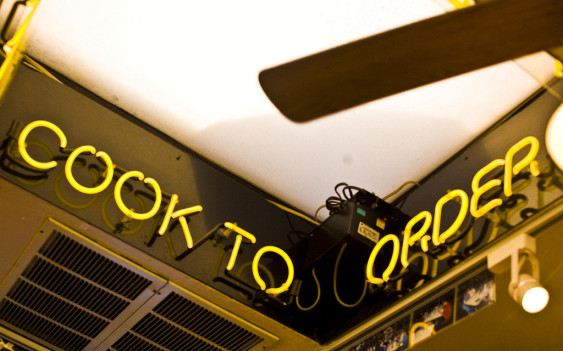Welcome to the Carbon Pricing Café! Do you have a reservation? Let’s see… oh yes, here you are: Washington State, table for 7 million. Right this way, please; we’ve got a spot for you by the window.
My name is Carbon Tax, and I’ll be your server today. You may know my twin sister, Cap-and-Trade, who sometimes covers for me. Some diners seem to have a strong preference between us, but in truth it really doesn’t matter that much; we can both deliver the goods.
(Besides, with all due respect to servers everywhere, when was the last time the most memorable part of a good meal was the service?)
We aim to provide a top-notch dining experience, and in order to do that our menu is limited. All we serve is carbon pricing, there are only a few really good entrées, and you only have to make two big decisions. (Remember, carbon tax and cap-and-trade are not entrée choices, and they don’t factor into the big decisions. People seem to forget that we’re your servers, not your meal.)
Two big decisions
Your first big decision is portion size: How high a carbon price do you want? Your answer will, of course, help determine how much carbon reduction you’ll get, but it will also help determine your carbon pricing revenue. (For the sake of comparison, a carbon price of $30 per ton CO2—as in British Columbia—will generate about $2 billion a year in revenue. A carbon price of $12 per ton CO2—as in California—will generate closer to $800 million a year.)

Reading the menu by Colie used under CC CREATIVECOMMONS.ORG licenses
This leads us to your second big decision: What do you want to do with the resulting revenue?
Let’s take the $30 price and put the resulting $2 billion in context: Washington State GDP is about $375 billion a year, the state government budget is about $40 billion a year, and state government tax revenue is about $20 billion a year. (Federal grants and other revenue sources make up the rest.) From this perspective you can see that $2 billion is significant but not overwhelmingly dominant in terms of state finances.
You can allocate the revenue however you want, of course, but the choices could be daunting. If I may, my personal recommendation would be to break down the $2 billion into a $1 billion entrée and a few side dishes.
Entrées and side dishes
For the entrée, I think—and again, this is just my recommendation—that there are only three really good options for you:
- Funding transportation infrastructure, which faces a $1 billion-a-year shortfall just for maintenance;
- Funding education, which faces an even bigger shortfall (the capital budget might be an especially promising target here); or
- Reducing the state sales tax from 6.5 percent to 5.5 percent, which would pencil out to about $1 billion a year.

Restaurant server by Robert Simmons used under CC CREATIVECOMMONS.ORG licenses
You may be surprised that I didn’t mention the dividend option of taking the carbon pricing revenue and cutting an equal per-capita check to everyone in the state. Unfortunately we had to take this item off the menu because of legal concerns (the Washington State Constitution suggests that public money can only be given to the “poor and infirm”) but you can still find this item at our sister restaurant, the Citizens’ Climate Lobby Café in Washington, DC.
We also have some amazing side dishes. Remember that you can have more than one!
- Financial support for low-income households, perhaps through the Working Families Tax Rebate
- Financial support for energy-intensive trade-exposed businesses, perhaps by reducing or eliminating the business and occupation (B&O) tax for manufacturers
- Financial support for clean energy and energy efficiency, perhaps following the model of the Efficiency Maine Trust.
Some people believe that last item should be an entrée rather than a side dish, but I’m skeptical that clean energy and energy efficiency projects could usefully absorb $1 billion a year in Washington State. It would be like trying to fit a milkshake into a teacup.
Wine list

Bar wines by Alex Brown used under CC CREATIVECOMMONS.ORG licenses
We also have an extensive (some would call it overwhelming) wine list. You’ll probably be better off asking the chef to create a delicious pairing for you, but here are the details if you wish to peruse them:
Coverage: Will you include “carbon by wire” (i.e., the carbon content associated with imported electricity)? Will you include fuel used by airplanes and ships that travel outside the state? Also, as a side note, the legal consensus is that a carbon price cannot encompass coal or oil shipments that might pass through the state en route to Asia or elsewhere; applying a carbon price to these shipments would likely be a violation of the Commerce Clause of the US Constitution.
Dynamics: How will the carbon price change over time to achieve stronger emissions reductions in the future? And how will this affect the revenue side of the equation?
Point of administration: In general, the further “upstream” you go—toward importers, refineries, the other first-point-of-contacts in the state—the easier it is to administer the carbon price. But there may be legal or simplicity arguments for layering the carbon price on top of existing taxes or regulations that are further “downstream.” Regardless, it’s important to note that much of the burden of the carbon price will end up being passed along to consumers; that’s how economics works, and from a carbon-reduction perspective, you want end users of carbon-based fuels to have a financial incentive to reduce emissions.
Legal issues: Will there be federal constitutional issues, such as with the Commerce Clause? (This is of special concern for coal by wire, the key issue being whether in-state and out-of-state companies are treated equally.) Will there be state constitutional issues, such as with the 18th Amendment restrictions on motor vehicle fuel revenue? (According to a unanimous decision last year by the state supreme court the answer would seem to be no, but legal issues are not always what they seem.)
Dessert
Did you save room for dessert? If so, there are some special questions that apply only to one or the other of the carbon tax and cap-and-trade twins. For example, the law can treat “taxes” and “fees” in very different ways. Carbon taxes in particular may bring up state expenditure limits or the 18th Amendment restrictions on motor vehicle fuels.
For cap-and-trade, the most important question is, California or Do-It-Yourself? A DIY approach would allow the state to go its own way, but it would take years and a big administrative staff to get a cap-and-trade program up and running. Joining California’s cap-and-trade system would simplify administration and implementation, but it would give Washington State less flexibility and make the state subject to the decisions of its much-larger neighbor regarding, for example, how to extend the cap-and-trade system into the 2020s.
Come back soon! And bring your friends and neighbors!
How was your meal? Delicious? I’m so glad to hear it.
Some people complain that our menu is confusing, but it’s not really that hard, and fundamentally there aren’t that many choices. You just have to figure out how strong of a policy you want (i.e., how high the tax or how tight the cap) and what to do with the resulting revenue (the revenue from a carbon tax or the economic value of permits from cap-and-trade) and your meal is complete.
One last thing: If you enjoyed your dinner, please tell your friends. Our business can only survive if our customer base includes a majority of the state legislature or a majority of the state’s voters!

Laughs at Otto’s by Anne Petersen used under CC CREATIVECOMMONS.ORG licenses










Weezy
None of the state or local government heads here should spend any time worrying about setting new policies relating to greenhouse gas emissions.
The “carbon footprint” of this state is tiny. Washington has per-capita the ninth lowest CO2 emissions of any state in the country:
http://en.wikipedia.org/wiki/List_of_U.S._states_by_carbon_dioxide_emissions
We do not need any additional state or local legislation of the types discussed here because we produce essentially none of the worlds GHG emissions.
If the government heads around here truly wanted to cut greenhouse gas emissions form this state they’d tax the heck out of Boeing, forcing it to conduct operations elsewhere. They’d also adopt a statute limiting use of SeaTac Airport by jet aircraft. The other easy step to take would be shutting down the cement factories around here and the one coal-burning electrical plant near Walla Walla. That would cut this state’s GHG footprint in half.
pinniped
Weezy, thanks for pointing out that table. WA does indeed do well on a per capita basis compared to other states. But your focus only on per capita emissions and only in comparison to other US states leaves out part of the story for at least 3 reasons. 1) Washington state is 22nd lowest in total CO2 emissions, so the total impact of cutting per capita emission could still be important. 2) WA’s per capita rate would put it in the top quartile of nations in the world, most of which are small, wealthy, oil rich nations, and total emission is roughly 10-20% of total emission of many highly developed or populous countries including Germany, UK, S. Korea, Mexico and Brazil, indicating that what we do matters 3) If laws that curb CO2 output can be shown to work without huge economic dislocation in the handful of states willing to try, then it might be adopted by some of the higher emitting states.
Paul Clapham
That looks like the “gerrymandering” excuse to me. The usual way to apply that excuse is to put yourself into a small group, compare your emissions to a larger group, observe that the larger group has higher emissions, and then point to that group and say that they should take action instead, because that would produce more of a result.
The ultimate version of that excuse is “I only produce a very small fraction of the world’s emissions so it won’t make any difference if I do nothing.” Which is the excuse actually used by a lot of people.
Point being, that’s an excuse which leads to failure.
David Moore
Agree with above comments that Boeing and airplane travel are huge greenhouse emitters and this should be heavily taxed to support public transit. I fly in a plane a couple of times every ten years or so. So Washington’s economy is not a small emitter in that it facilitates airplane travel ruining the future of the worlds poorest and most vulnerable to sea level rise, stronger hurricanes, drought etc.